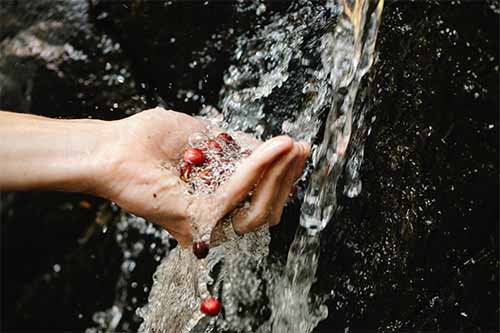Addition to the family.
We are super excited to announce that we have a new roaster that has come to join Bean Merchant. Sacred Grounds has been built to

There are three different processes the coffee can go through after it has been picked. Wet (washed), Dry, and Semi-Dry. Each of these processes significantly alters the taste of the coffee brewed with the end product (coffee beans). Some of the processes are also more aligned with certain regions, for example, the dry process is more often used in places like Ethiopia, where the climate is hotter and drier, and the altitude the beans are grown at higher. This brings out the fruity flavours in the coffee beans.
With the wet process, the ripe and unripe fruit are sorted by submerging them in water. The pulp is then removed from the fruit by pressing it through a submerged machine. The coffee is dried in the sun, until only about 12-13% moisture remains, and brought down to 10% by machine. This process produces clean, bright, fruitier coffee with little body.
The semi-dry process is also called “wet-hulled”, “semi-washed”, “pulped natural” or, in Indonesia, Giling Basah. In this process, pulping machines remove the pulp from the bean, the beans are stored for a day, washed, and then dried in the sun until they contain 10-12% moisture content. This process is a median between the dry and wet processes and produces coffee that is sweet, and rich, with a medium body.
The dry process involves sorting the coffee beans by winnowing them with a large sieve. They are then laid out in the sun to be turned and raked for up to four weeks, after which time they are taken to the mill to be hulled, sorted, and bagged. This coffee produces funky coffee that is a wide variety of flavours and tastes. It can create fruity, sweet, thick complex coffee that is rich with a big body.
A fourth coffee process that has come to fame more in recent years is Luwak coffee. In this process, little animals sort of like raccoons eats the coffee fruit off the tree, beans and all. Later on, the farmer will collect beans from the Luwak’s faeces, and clean them up. The claim for this type of coffee is that the Luwak will only eat the ripest fruit, meaning that only the choicest beans are selected for drinking. I’ve tried some, and it’s pretty good. It’s the thought of where those beans have been that puts me off every time!
The different processing methods radically change the taste in your cup, and it’s important to know how your beans have been processed so that you can ensure you’re getting the flavours you want in every coffee you drink. All roasters should know how their coffee beans have been processed and should have this information freely available on the website. There’s a lot more than just processing method to take into account when choosing coffee though. If you would like some help with that, our quiz will ask you a few questions to determine your taste profile and then match you with coffee beans from around New Zealand.
We are super excited to announce that we have a new roaster that has come to join Bean Merchant. Sacred Grounds has been built to

It’s here! At last! The final touches are being put onto our website, the last discussions are going down with roasters, and we are ready
Contact Us:
8 Benhar Close,
Kelson,
Wellington,
NZ.
Call:
022 108 3212
Email:
Contact@beanmerchant-dev.10web.me
Copyright ©️ 2024 Bean Merchant. All Rights Reserved.
We do not hold financial information, all secure data is encrypted via Stripe.
Try our unique coffee flavour profiling quiz to find your perfect coffee beans.
Bean Merchant is New Zealand’s most relied upon curator for home coffee delivery. Whatever coffee flavours you are after, we have the widest variety to choose from.